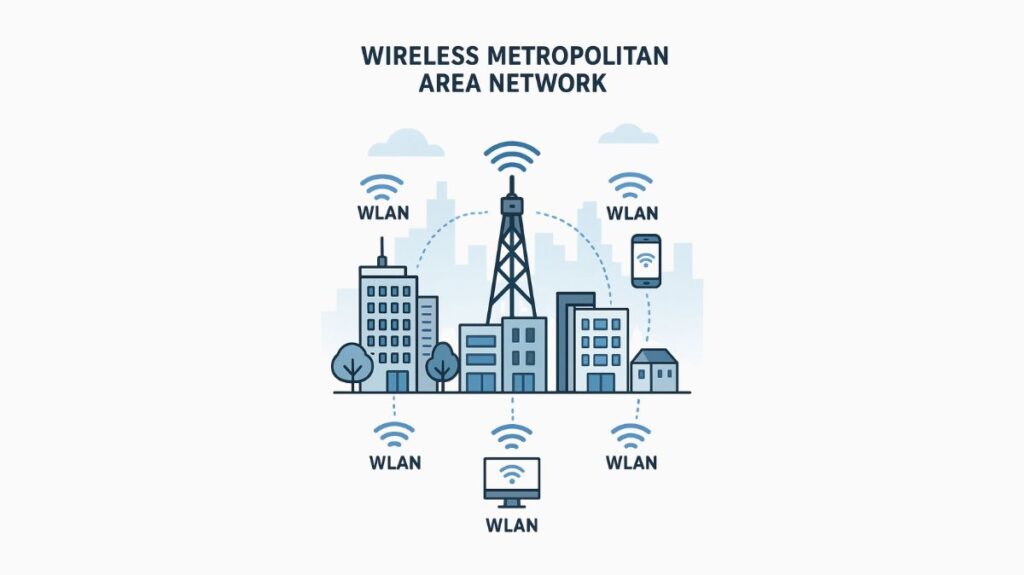Wireless Metropolitan Area Networks

A wireless metropolitan area network (WMAN) is a wireless network that provides users and devices with high-speed data access across long distances over a wide geographic area, such as a city. The wireless wide area network (WWAN) is smaller than the wireless local area network (WLAN), although the former is larger. WMANs are usually only accessible by authorized users, can be point-to-point or point-to-multipoint, and are frequently controlled by a single organization, such as an ISP.
Providing high-speed wireless access across this vast geographic area is a WMAN’s main goal.
You can also read Advantges Of Transport Layer Security TSL And How It Works
Geographic Scope and Range
Based on their coverage range, WMANs can be categorized as either small or big network types:
- Size Comparison: A WMAN is typically smaller than a Wireless Wide Area Network (WWAN), which is frequently cellular-based and covers large areas like countries, but larger than a Wireless Local Area Network (WLAN), which covers a home or office.
- Coverage Area: A wireless system is referred to as a WMAN when it covers an entire town or city. It usually spans a radius of up to 50 km (about 31 miles) and links several places within a geographic area.
- Distance: WMANs typically travel more than 100 meters.
Characteristics and Management
WMAN deployment and operation are defined by key characteristics:
- Topology: Point-to-Point and Point-to-Multipoint networks are two types of WMAN connectivity.
- Service: From a single access point, they offer service to numerous nodes.
- Deployment: For a WMAN to operate effectively, a line of sight between each hub or building must be maintained.
- Ownership and Access: A WMAN is often under the control of a single organization, such as a government agency, a big business, or an Internet service provider (ISP). Access is limited and needs the providers’ permission.
WMAN Technologies
WMANs make use of wireless technologies, primarily those that adhere to IEEE 802.16:
- WiMAX (Wireless Interoperable Metropolitan Area Exchange): The most widely used WMAN technology is called WiMAX (Wireless Interoperable Metropolitan Area Exchange). The IEEE 802.16 family of standards, which specify protocols for broadband wireless access, serves as its foundation. Like a cell phone network, WiMAX offers high-speed broadband service and wide wireless access coverage. Among the spectrum bands in which it works are 2.3GHz, 2.5GHz, 3.5GHz, and 5.8GHz.
- Local Multipoint Distributed Service (LMDS): The broadband microwave wireless transmission system known as Local Multipoint Distributed Service (LMDS) offers dependable digital two-way voice, data, and Internet services. Using low-powered, high frequencies (25 to 31 GHz) over a short distance, it is a point-to-multipoint system.
- Multi-Channel Multipoint Distributed Service (MMDS): Multi-Channel Multipoint Distributed Service (MMDS) is a wireless telecommunication technology that operates in the ultra-high-frequency (UHF) region of the radio spectrum between 2.5GHz and 2.7GHz. It was formerly known as Wireless Cable or Broadband Radio Service (BRS).
| Standard | Associated Technology | Network Type | Description |
| IEEE 802.16 | WiMAX | WMAN | Provides high-speed, long-range wireless connectivity(up to ≈ 50km). |
| IEEE 802.11 | Wi-Fi | WLAN (Local) | Used for short-range wireless access in homes, offices, and hotspots. |
| IEEE 802.15 | Bluetooth | WPAN (Personal) | Used for connecting personal devices over a very short range. |
You can also read What is the Cisco AnyConnect Secure Mobility Client in CCNA
Types and Applications
There are two basic types of WMANs:
- Back haul: Usually used for cellular-tower connections, this kind of network is an enterprise network. It often makes use of fixed wireless, which is typically quicker and less expensive than regular fiber optic connections, saving substantial sums of money every year.
- Last mile: This is utilized in situations where traditional wired service, such as cable modems or DSL broadband, may be interrupted or unavailable, such as on huge building sites. It can link many buildings in a city or campus and provide a last-mile connection.
Common applications and examples of WMANs include:
- Often free or less expensive than other broadband services, municipal Wi-Fi projects provide high-speed Internet connectivity to citizens throughout entire towns or metropolitan areas.
- Connecting municipal systems, such as cameras and traffic monitoring.
- Networks on educational campuses and in corporations.
- Serving as telecom operators’ and ISPs’ wireless backbone or backhaul.
- WiMAX and WiBro are two instances of WMAN implementations.
Benefits of WMAN
WMANs have a number of benefits, especially when it comes to cost effectiveness and deployment:
- Within a metropolitan area, they encompass several locations.
- They lower the significant infrastructure expenses related to leasing lines and installing copper or fiber cabling.
- They act as wired network backups.
- In contrast to fiber or cable networks, WMANs are distinguished by their wide reach, scalability, and simplicity of deployment.
- They facilitate data, audio, and video transmission.
You can also read What is WPA2 Enterprise, Core Architecture and Configuration
